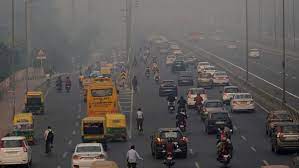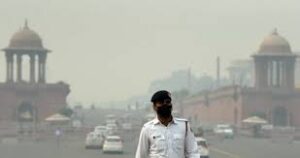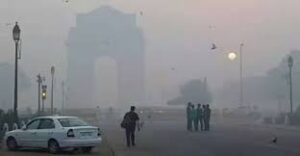Delhi govt forms Special Task Force to combat pollution
Delhi govt forms Special Task Force to combat pollution
The Special Task Force will constitute six members and will be led by the Delhi government’s Special Secretary (Environment).

Delhi govt forms Special Task Force to combat pollution in the national capital, PTI reported.
” The current situation is such that for 2-3 days the AQI is going to remain in the ‘very poor’ category only because as per the prediction for tomorrow, the wind speed…will remain low…till wind speed increases, the AQI will stay in ‘very poor’ category”,” Delhi minister Gopal Rai told ANI.
“By looking at this, a decision has been taken today that we need to monitor the implementation of GRAP-4 on the ground…for that 6-member Special Task Force has been formed, Special Secretary Environment will be in-charge of this,” the minister added.
Delhi air quality LIVE:
Delhi Environment Minister Gopal Rai is scheduled to conduct a meeting on Thursday with various departments to discuss the efficient execution of measures specified in the central air pollution control plan, according to officials.

The meeting is set to take place at 1 pm at the Delhi Secretariat.
Meanwhile, Delhi, NCR regions are experiencing ‘very poor’ air quality on Thursday. As per SAFAR data, the overall air quality in the national capital stood at 386.
As per the Central Pollution Control Board (CPCB), the air quality at 7 am in Bawana was recorded at 442, RK Puram was 418 in Jahangirpuri it was 441 in Dwarka it was 416 in Alipur 415, in Anand Vihar at 412, in ITO it was 412 and near the Delhi airport the AQI was recorded at 401.
An official from the Commission for Air Quality Management (CAQM) announced on Tuesday that the final stage of the central government’s air pollution control plan, known as the Graded Response Action Plan (GRAP), will persist.

Stringent measures, including a prohibition on construction activities and the entry of pollution-emitting trucks into the national capital, will continue until further directives are issued, PTI reported.
The poisonous haze blanketing Delhi thickened on Wednesday with the air quality standing close to the “severe” category amid unfavorable meteorological conditions.
The national capital’s Air Quality Index (AQI) stood at 392 at 8 a.m. The 24-hour average AQI, recorded at 4 p.m. every day, was 397 on Tuesday. It was 358 on Monday and 218 on Sunday.
‘Breathing toxic air is equivalent to smoking at least 10 cigarettes a day’: AIIMS doctor
Air pollution levels entered the severe category (AQI above 400) at many places within the city, including ITO (427), RK Puram (422), Punjabi Bagh (432), IGI Airport (404), Dwarka (416), Patparganj (417), Sonia Vihar (413), Rohini (421), Nehru Nagar (434) and Anand Vihar (430).

Neighbouring Ghaziabad (362), Gurugram (322), Greater Noida (312), Noida (364) and Faridabad (369) also recorded very poor air quality.
An AQI between zero and 50 is considered ‘good’, 51 and 100 ‘satisfactory’, 101 and 200 ‘moderate’, 201 and 300 ‘poor’, 301 and 400 ‘very poor’, 401 and 450 ‘severe’ and above 450 ‘severe plus’.
According to IQAir, a Swiss company that specialises in air quality monitoring, Delhi was the most polluted city in the world on Tuesday, followed by Dhaka, Lahore and Mumbai.
According to a system developed by the Pune-based Indian Institute of Tropical Meteorology to identify the contribution of different pollution sources, stubble-burning accounted for 12 per cent of the air pollution in the capital on Tuesday. It is likely to be 14 per cent on Wednesday and six per cent on Thursday.
Delhi most polluted; Mumbai and Kolkata too on Swiss list: Delhi govt forms Special Task Force to combat pollution
An official of the Commission for Air Quality Management (CAQM) said stringent measures, including a ban on construction work and the entry of polluting trucks in the national capital, under the final stage of the central government’s air pollution control plan called the Graded Response Action Plan (GRAP) will continue until further orders.
“Stubble burning incidents are rising again and the meteorological conditions are not favourable (for dispersion of pollutants). We will review the situation and act accordingly,” the official added.
Doctors say breathing in the polluted air of Delhi is equivalent to the harmful effects of smoking approximately 10 cigarettes a day.
Prolonged exposure to high levels of pollution can cause or exacerbate respiratory problems such as asthma, bronchitis and chronic obstructive pulmonary disease (COPD) and dramatically raise the risk of cardiovascular disease, they said.
Unfavourable meteorological conditions, combined with vehicular emissions, paddy-straw burning, firecrackers and other local pollution sources, contribute to hazardous air quality levels in Delhi-NCR during winters.
According to a Delhi Pollution Control Committee (DPCC) analysis, the city experiences peak pollution from November 1 to 15, when the number of stubble-burning incidents in Punjab and Haryana increases.
Delhi’s air quality ranks among the worst in the world’s capital cities.
According to a report compiled by the Energy Policy Institute at the University of Chicago (EPIC) in August, air pollution is shortening lives by almost 12 years in Delhi.
